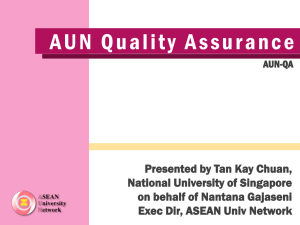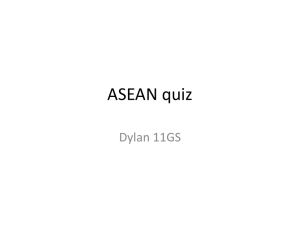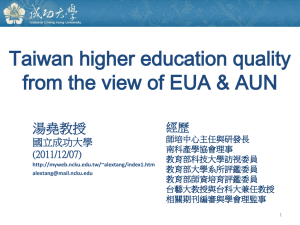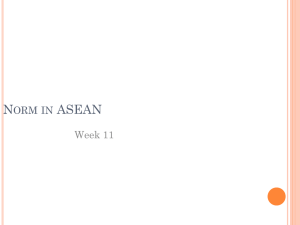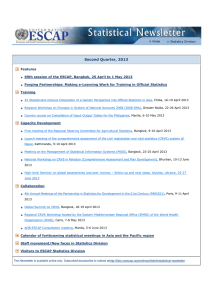30 November 2007 Contents Indicators for the new target on
advertisement
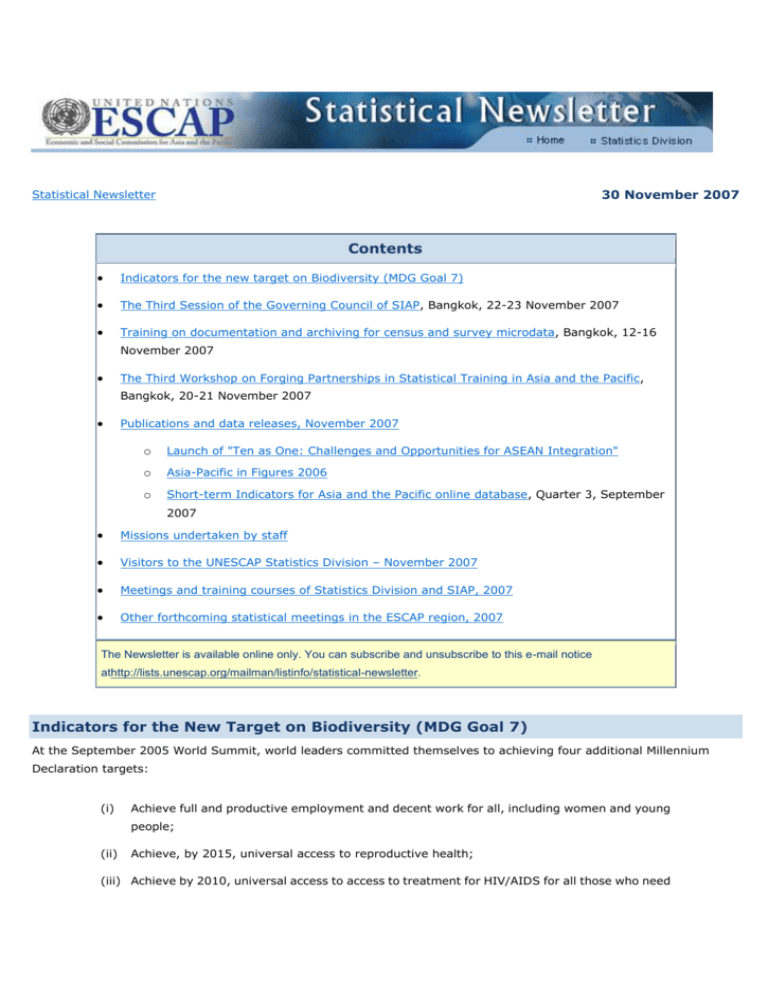
30 November 2007 Statistical Newsletter Contents Indicators for the new target on Biodiversity (MDG Goal 7) The Third Session of the Governing Council of SIAP, Bangkok, 22-23 November 2007 Training on documentation and archiving for census and survey microdata, Bangkok, 12-16 November 2007 The Third Workshop on Forging Partnerships in Statistical Training in Asia and the Pacific, Bangkok, 20-21 November 2007 Publications and data releases, November 2007 o Launch of "Ten as One: Challenges and Opportunities for ASEAN Integration" o Asia-Pacific in Figures 2006 o Short-term Indicators for Asia and the Pacific online database, Quarter 3, September 2007 Missions undertaken by staff Visitors to the UNESCAP Statistics Division – November 2007 Meetings and training courses of Statistics Division and SIAP, 2007 Other forthcoming statistical meetings in the ESCAP region, 2007 The Newsletter is available online only. You can subscribe and unsubscribe to this e-mail notice athttp://lists.unescap.org/mailman/listinfo/statistical-newsletter. Indicators for the New Target on Biodiversity (MDG Goal 7) At the September 2005 World Summit, world leaders committed themselves to achieving four additional Millennium Declaration targets: (i) Achieve full and productive employment and decent work for all, including women and young people; (ii) Achieve, by 2015, universal access to reproductive health; (iii) Achieve by 2010, universal access to access to treatment for HIV/AIDS for all those who need it; (iv) Reduce biodiversity loss, achieving, by 2010, a significant reduction in the rate of loss; In this edition of the Newsletter, rationale, methodology, data sources and data availability of the new indicators for monitoring the new target on reducing the loss of biodiversity selected by the Inter-Agency Expert Group on MDG indicators are discussed. In 1992, the United Nations Conference on Environment and Development (the Earth Summit) defined biodiversity as "the variability among living organisms from all sources", including "diversity within species, between species and of ecosystems". The loss of biodiversity, especially the extinction of species, has increased significantly during the last century, mainly due to human activities. Key factors contributing to the loss are overpopulation, deforestation, pollution (air, water and soil contamination) and global warming, which, combined, produce a cumulative negative impact on biodiversity. Following the adoption of the Plan of Implementation of the World Summit on Sustainable Development, the Secretary-General proposed that a new target be included for Goal 7 aiming at reducing the loss of biodiversity by 2010. However, the deadline is only three years away and the time left may not be sufficient to achieve tangible results. The indicators selected for the new target are as follows: Proportion of species threatened with extinction; Proportion of fish stocks within safe biological limits; Proportion of total water resources used; Proportion of terrestrial and marine areas protected. These indicators are monitored by the World Conservation Union (IUCN), in coordination with the United Nations Environment Programme and the Food and Agriculture Organization of the United Nations. The proportion of species threatened with extinction is a standard measure of the loss of biodiversity. The indicator is based on the IUCN Red List index, which applies quantitative criteria based on population size, the rate of decline and the area of distribution to assign categories of relative extinction risk, such as "vulnerable", "endangered" or "critically endangered". The index is based on both the proportion of species in each category and the changes in this proportion over time resulting from improvement or deterioration in the status of individual species. Global assessments have been conducted every four years since 1988. The 2004 IUCN Red List contains 15,589 species threatened with extinction. The assessment includes species from a broad range of taxonomic groups, including vertebrates, invertebrates, plants and fungi. However, this figure is an underestimate of the total number of threatened species as it is based on an assessment of less than 3 per cent of the world's 1.9 million species. In addition to global assessments, national assessments have recently been conducted, but so far only 15 national red lists meet the IUCN criteria. National-scale assessments cannot be aggregated to obtain regional and global assessments as they are not designed for global species populations. At the international level, overfishing is of great concern for it has contributed to endangering a number of maritime species. To monitor this problem, the indicator proposed is the proportion of fish stocks within safe biological limits. In general terms, a fish stock is considered to be within safe biological limits if its current biomass is above the value corresponding to the precautionary threshold advocated by the International Council for the Exploration of the Sea. The indicator, however, is designed only for global and regional assessments, and not for national ones, as overfishing does not affect, for instance, landlocked countries. Furthermore, individual country assessments are of little importance because fishing that affects the proportion of nation-specific fish stocks may be caused by other countries. Water is a crucial resource for life and plays a central role in people's daily activities. Human development depends on an adequate water supply, a deciding factor for the location of communities, the extent of agriculture, and the shape of industry and transportation for centuries. Nevertheless, water policies in most nations are failing to protect the life's most vital resource. Increasing water scarcity and alarming declines in the health of aquatic ecosystems worldwide are inevitable consequences. Better management of water resources is therefore the key to mitigating water scarcities in the future. The proportion of total water resources used is the indicator selected to monitor the management of this pressing issue. This indicator, however, has several limitations. Water supply and demand are very difficult to measure. Even countries with well-developed statistical systems have not been able to produce satisfactory data. Water supply in particular is difficult to measure accurately. In many rural areas, for example, the main water supply is a river that may run through a number of countries. In addition, water can be recycled and reused a number of times, which greatly expands its supply. The list of proposed indicators is complemented by indicator 26, the ratio of area protected to maintain biological diversity to surface area, which is currently an indicator for target 9: Integrate the principles of sustainable development into country policies and programmes and reverse the loss of environmental resources. It has been proposed that this indicator be reformulated to monitor terrestrial and marine habitats separately (proportion of terrestrial and marine areas protected). The establishment of protected areas is an important mechanism for preserving the natural habitat and, consequently, for controlling the decline in biodiversity. In addition, protected areas have become places of high economic and social value (supporting local livelihoods; protecting watersheds from erosion; harbouring a countless wealth of genetic resources; supporting thriving recreation and tourism industries; providing for science, research and education; and forming a basis for cultural and other non-material values). Data are collected by the United Nations Environment Programme World Conservation Monitoring Centre from ministries of environment and other ministries responsible for designation and maintenance of protected areas at the national level. Sites protected under local or provincial laws are therefore not included. Moreover, the designation of protected areas does not necessarily ensure enforcement of the protection measures. The effectiveness of policy measures in reducing biodiversity loss may ultimately depend on a range of management and implementation factors not covered by the indicator. The Third Session of the Governing Council of SIAP, Bangkok, 22-23 November 2007 The third session of the Governing Council of SIAP was held at the United Nations Conference Centre, Bangkok, Thailand on 22-23 November 2007. Representatives of all nine members of the Council: China, India, Indonesia, Japan, Islamic Republic of Iran, Malaysia, Pakistan, Republic of Korea, and Thailand, as well as representatives from Australia, Fiji, Hong Kong, China; Macao, China; Maldives, Mongolia, Myanmar, New Zealand, Philippines and Viet Nam as observers attended the session. Representatives of the following United Nations bodies, specialized agencies and intergovernmental organizations also participated as observers: ASEAN, FAO, ILO, IMF, Secretariat of the Pacific Community (SPC), UNECE, UNESCO Institute for Statistics, and UNFPA. Mr Feng Nailin, representative of China, was re-elected as chairperson of the third session of the Governing Council of SIAP. The Council reviewed the budget and implementation of work programme for the period since the second session held on 2-3 November 2006. Over the reporting period, SIAP completed four Tokyo Metropolitan Area-based (TMA) group training courses, seven regional and subregional training activities, including one research based regional course and nine country training courses amounting to 16 courses under the Outreach Programme. SIAP trained a total of 482 participants from 60 countries, 97 percent of them, or 465 participants, from 47 countries in the ESCAP region while the remaining 17 participants were from 13 countries outside the region. The number of participants trained in the TMA-based courses was 76 whereas the regional and subregional training activities together accommodated 355 participants. 51 participants were trained under the distance training programme. The TMA-based courses were organized in collaboration with the Japan International Cooperating Agency (JICA) and covered several fields of statistics from Fundamental Official Statistics in its six-month modular course, Information and Communications Technology for statistical production, to Analysis and Interpretation of Statistics. The Director reported that the Institute had completed the implementation of the three-year (AY 2004-2006) extended outreach-training programme. During the last three academic years, AY 2005-2007, the Institute conducted 30 regional and subregional training activities and 17 country courses which trained 1,127 participants in total - a significant increase in the number of training courses from 38 in the preceding three-year period, AY 2002-2004, to 47 in AY 2005-2007. The number of participants also increased by 22 percent from 926 to 1,127. The outreach training activities were organized in collaboration with country partner institutions and national statistical offices as well as international organizations. The Institute conducted two distance training courses on a trial basis using JICA net services in its field offices. The work programme for academic year (AY) 2008 and 2009 was endorsed. However, the Council raised the concern that the current financial situation was not sustainable in the medium to long-term if the current work programme of SIAP were to be maintained at the same level. Several suggestions were made to encourage countries to increase their cash and in-kind contributions, including the use of cost sharing arrangements. The Council urged SIAP to submit a strategic plan with options for ensuring the medium to long-term sustainability of the Institute. The Council acknowledged with deep appreciation the governments of Australia, Brunei Darussalam, Fiji, Hong Kong, China; Indonesia, Islamic Republic of Iran, Japan, Kiribati, Malaysia, Maldives, New Zealand, Pakistan, Philippines, and Republic of Korea, Sri Lanka, Thailand, contributing members and associate members in the region, ESCAP, ILO, IMF,SPC, UNDP, UNSD and UIS. Training on documentation and archiving for census and survey microdata, Bangkok, 12-16 November 2007 ESCAP Statistics Division organized the Training on documentation and archiving for census and survey microdata in Bangkok, 12-16 November, 2007. The training was part of the ESCAP Microdata Management Project, which aims to improve capacity of survey and census organizations in the region for providing access to microdata. The project is implemented by the Statistics Division and is part of the global Accelerated Data Program (ADP) initiative (www.surveynetwork.org/adp). The training was attended by 19 participants from national statistical agencies in 10 ESCAP member countries (Bangladesh, Cambodia, Fiji, India, Indonesia, Lao PDR, Mongolia, Philippines, Sri Lanka and Viet Nam). The five-day curriculum covered multiple topics related to microdata management practices and especially focused on hands-on practical work on documentation of survey or census microdata produced by the participants' respective agencies. Documentation and archiving of each participant's micro datasets were accomplished using the International Household Survey Network (IHSN) Microdata Management Toolkit. As the Toolkit is a relatively new software package, most trainees had no prior experience with the software. During the week, the functions of the tools were demonstrated, followed by sessions in which trainees completed documentation for their own microdata and posed questions to the trainers. The main goal was to build capacity of the participants with the intention that they would pass on skills and lessons learned and ultimately help implement improved microdata management practices as part of their home country survey and census operations. Participants recognized and appreciated the usefulness of the toolkit to address their documentation and archiving needs and expressed positive feedback for the topics covered by the training. At the conclusion, trainees expressed a confidence in their ability to deliver similar trainings to their colleagues upon return to their home offices. The Third Workshop on Forging Partnerships in Statistical Training in Asia and the Pacific, Bangkok, 20-21 November 2007 The Statistical Institute for Asia and the Pacific (SIAP), in collaboration with the Statistics Division of the United Nations Economic and Social Commission for Asia and the Pacific (ESCAP), organized the third workshop on "Forging Partnerships in Statistical Training in Asia and the Pacific" at the United Nations Conference Centre in Bangkok, Thailand, on 20-21 November 2007. The heads of the national statistical training institutes, representatives from international organizations as well as national statistical agencies involved in capacity building in official statistics in the region were invited to the workshop. This workshop was the third in a series which aims to develop effective and efficient statistical training at the national level. Due to the growing demand for better statistics, systematic training of government statisticians has become a fundamental component of national statistical systems. The main objectives of the third workshop were: (a) to review the recommendations of the first and second workshops; (b) to propose strategies to develop relevant country training programmes in statistics; and (c) exchange views on feasible coordination mechanisms for training programmes in official statistics at the country level. Twenty seven participants from 17 national statistical agencies and statistical training institutes and five representatives from international organizations attended the workshop. Mr Tomas P. Africa, former director of SIAP, acted as facilitator and consultant for the workshop. Mr Pietro Gennari, Chief of the Statistics Division, ESCAP, delivered the opening speech in which he briefly described what had been carried out by SIAP and ESCAP since the second workshop on forging partnerships. He encouraged countries and international organizations to cooperate actively in statistical trainings for official statisticians. All four country partner institutes: BPS-Statistics Indonesia, Statistical Research and Training Centre of Statistical Centre of Iran, Statistical Training Institute of the KNSO and Statistical Research and Training Centre of the Philippines, presented their training programmes at both regional and national levels in their home country. They emphasized the positive impact of cooperation with SIAP in running statistical training courses. The themes of the sessions were: "Strategies to develop training programmes for official statisticians at the country level"; "How to coordinate training activities at the country level"; and "Review of the recommendations of the first and second workshops on Forging Partnerships in Statistical Training in Asia and the Pacific". Under the theme "Strategies to develop training programmes for official statisticians at the country level", ABS Australia, NBS China, CSD Hong Kong, China, CSO India and SNZ New Zealand presented their training activities and some of them offered to conduct country courses in collaboration with SIAP. A presentation on "How to coordinate training activities at the country level" was delivered by ESCAP, SIAP, ASEAN, FAO, SPC, UNFPA, ILO and PARIS 21. The review of the recommendations of the first and second workshops was presented by Mr Tomas P. Africa which discussed: creation of a task force under the Sub-Committee on Statistics; setting up of websites, creation of training materials in electronic format (e-library) and development of e-learning system. The workshop concluded that there was a need for a mandated organization to undertake coordination of statistical training in the region. Publications and data releases, November 2007 Launch of "Ten as One: Challenges and Opportunities for ASEAN Integration" On November 19 the study, Ten as One: Challenges and Opportunities for ASEAN Integration, was released to coincide with the 13 th ASEAN Summit, in Singapore. The study, prepared by an inter-divisional research team coordinated by Pietro Gennari-director of the Statistics Division, is the first in a new ESCAP series on inclusive and sustainable development that aims to provide strategic analysis of key Asia-Pacific issues and contribute to regional and subregional policy dialogue and solutions.The study outlines the major challenges for ASEAN integration and recommends key actions for ASEAN integration. The many achievements of ASEAN notwithstanding, the study notes serious development gaps between its members. These disparities need to be bridged urgently to prevent losers of the integration process from being permanently left behind. The largest disparities pertain to some environmental and health issues. The ASEAN contribution to global carbon emissions is relatively small -- about 3.3 per cent of the global total, while its share of the world population is 7.7 per cent. However, Brunei Darussalam, Singapore and Malaysia exceed the world average of per capita CO2 emissions by a large margin. Brunei Darussalam's per capita emissions rate is over 60,000 times higher than that of Cambodia. Disparities in health are stark. The child and maternal mortality rates of Cambodia, the Lao People's Democratic Republic and Myanmar, for example, are between 11 and 47 times higher than those of Singapore. In trade and investment, huge gaps remain between ASEAN members. Intraregional trade remains at a low level of one quarter of total ASEAN trade, despite the liberalization efforts under the ASEAN Free Trade Area (AFTA) agreement. Foreign direct investment (FDI) in ASEAN has been heavily skewed, with four countries, Singapore, Malaysia, Thailand and Viet Nam, taking in 93 per cent of all FDI inflows. Intra-ASEAN FDI has been low and stagnant. In addition to development gaps, the study identifies a lack of reliable and timely statistical data and inadequate governance as two other key challenges that ASEAN faces. On governance, some countries trail behind the world average in indicators related to freedom of expression, association and media, quality of policy formulation and implementation, rule of law, and corruption. Member countries that are relatively well-off also do not rank commensurately in one or another of these indicators. The study examines current ASEAN initiatives and identifies areas where actions need to be strengthened and transformed into genuine integration mechanisms. For example, on cross-border human mobility, the study finds that the economic benefits from migration are clouded in several countries by concerns over social costs and unintended consequences of migration policies. The report calls on ASEAN to promote a regional strategy for managing migration in a coordinated and integrated manner. The migration-development nexus and the role of remittances in poverty reduction, as well as the gender dimensions of migration in ASEAN should also be addressed. ESCAP emphasizes that efforts towards regional integration will require all ASEAN members to obtain minimum levels for economic and social development for them to be in a position to benefit from the envisaged free movement in various spheres. The report identifies three key areas where actions are required. First, governance: this includes transparency and access to reliable information and data. The study points out that the economic benefits of ASEAN integration will not serve to ensure domestic political stability, if the poor do not have a share in development benefits and if the environment is damaged leading to imperilled livelihoods for the most vulnerable citizens. The study states that ASEAN's approach of "non-intervention" in national issues has limited the effectiveness of agreements, declarations and action plans. As ASEAN integrates further, multilateral governance for agreed goals among member States needs to be strengthened. Second, cohesion policy: the ASEAN vision on the new freedom of movement will only be sustainable if supported by a cohesion policy aimed at narrowing the gaps between winners and losers of the integration process. The policy requires financial transfers for social, economic and environmental development and strengthening social safety nets. Third, trans-ASEAN networks: as the backbone for the envisaged freedom of movement, network infrastructures and services in transport, ICT, energy and water need to reflect a regional rather than a national perspective. The report calls on governments, for example, to play a larger role in cross-border transports projects, even in projects which are private sector-driven. It also urges ASEAN to integrate its ICT sector to enhance its competitiveness. Asia-Pacific in Figures 2006 This is the final printed of the statistical pocketbook that has been published annually since 1987. It uses a one-country-one-page format and contains selected socio-economic indicators on population; health, education and culture; national accounts and prices; trade; transport and tourism; finance; labour force and production; natural resources and environment; and development. (Published date: 19 November 2007) Short-term Indicators for Asia and the Pacific online database, Quarter 3, September 2007 The online database contains time series data for 31 of the regional members and associate members of ESCAP and is designed to provide up-to-date monthly (or quarterly) data to assess economic trends for countries or areas in the region. The online database covers the period from January 2003 and is updated every quarter.(Last update: 8 November 2007) ESCAP publications: http://www.unescap.org/publications/ Missions undertaken by staff Ms Margarita F. Guerrero, Regional Adviser on Statistics, Statistics Division, and Ms Zeynep Orhun, Associate Statistician, Statistical Information Services Section, Statistics Division: Tehran, Iran (Islamic Republic of), 10-13 November 2007: To participate as resource persons in the Workshop on Integrated Economic Statistics and Informal Sector for ECO Member Countries organized collaboratively by UNSD, ESCAP, Statistical Center of Iran and Economic Cooperation Organization. Ms Guerrero and Ms Orhun participated in all workshop sessions and delivered presentations on informal sector statistical concepts, informal sector measurement tools and the Unified Data Collection Strategy of the Development Account Project "Interregional Cooperation on the Measurement of Informal Sector and Informal Employment". Visitors to the UNESCAP Statistics Division - November 2007 Dr Susan Teltscher, Chief, ICT Policy and Analysis Section, ICT and E-Business Branch, UNCTAD, Geneva, Switzerland Ms Esperanza Magpantay, Statistician, ITU, Geneva, Switzerland Mr Julian Payne, Consultant on ADB-ESCAP Partnership Ms Jessica Gardner, Associate Statistician UNECE, Geneva, Switzerland Meetings and training courses of Statistics Division and SIAP, 2007 The list of future events is provided for coordination purposes only. The list is incomplete and events, dates and venues may change. Please do not publish or disseminate the list without confirming the latest information with the Statistics Division or SIAP, as appropriate. Note that not all meetings are intended for all countries. Date Organizer Meeting Venue 10-12 SD Expert Group Meeting on Effective Use of IT in Population Censuses Bangkok SIAP Country Course on Small Area Estimation,http://www.unsiap.or.jp/ Colombo Poverty and Fourth session of the Committee on Poverty Reduction Bangkok Noumea December 10-14 December 12-14 December Development Division (PDD), SD 5 days in UNSD, SPC, Workshop on census related issued to be determined in the Pacific February SD Region, http://unstats.un.org,http://www.unescap.org/stat/, http://www.spc.int 2008 Other forthcoming statistical meetings in the ESCAP region, 2007 The following list of future events has been compiled, for coordination purposes only, on the basis of information available to the Statistics Division as of 30 November 2007. Readers are strongly advised to verify the correctness with the indicated organizers. Events, dates and venues may change. Please do not republish or disseminate the list. Date Organizer Meeting Venue 11-14 FAO Expert Consultation on Statistics for Farmer's Bangkok December 17-18 Income, http://www.fao.org/ ASEAN Secretariat December The 8th ASEAN Heads of Statistical Offices Meeting Phnom (AHSOM), http://www.aseansec.org/ Penh Colombo 7-8 January Applied Statistics The first National Conference on 2008 Association of Sri Lanka Statistics,http://www.pgia.ac.lk/asasl (ASASL) The calendar of statistical meetings in Asia and the Pacific is maintained on ESCAP web sitehttp://www.unescap.org/stat/meet/events_Asia_Pacific.asp PARIS21 is maintaining event calendars for Africa and Asia at http://www.paris21.org/pages/events/all-events/list/ Copyright (c) 2013 ESCAP | Legal Notice

